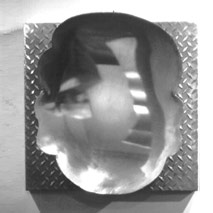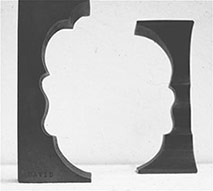 Exhibition Kornblee Gallery 1963
Exhibition Kornblee Gallery 1963
Cut-Outs 1962-1966
One day in early 1962, when a mechanical problem prevented him from welding, David Jacobs noticed his shadow fall across the surface of his drawing pad. This small epiphany inspired a series of “Cut-Out” sculptures in the mid-1960s. The earliest versions were made with large panels of brightly painted plywood, from which Jacobs excised bold silhouettes of male and female figures, displaying both the positive shapes and their negative frames in close proximity. By the summer he was cutting similar sculptures from steel plates, including Red Man, which was awarded first prize by Henry Geldzahler at a juried exhibition in Ohio, and Steel Head, which later entered the permanent collection of the Guggenheim Museum.
In the fall of 1962 Jacobs accepted a new teaching position at Hofstra University and settled in Sea Cliff, New York. From there he continued work on the “Cut-Outs”, showing several of them in his second show at the Kornblee Gallery in March 1963. A subsequent show at Kornblee featured the pivotal Man Monument (1964), which expanded the silhouette format into three dimensions. This arch-like structure permits viewers to walk through the contours of a man’s head and shoulders. By 1965 other “Cut-Out” sculptures had reinforced this shift from strictly pictorial to phenomenological concerns, as works like Head Columns and Leaning Column are gradually apprehended by viewers moving through time and space.


















